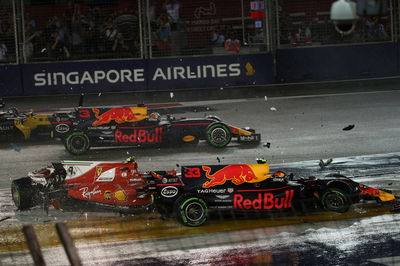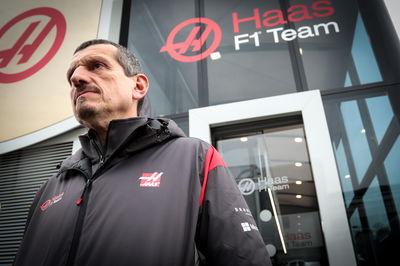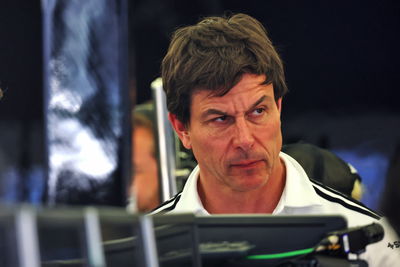The sense behind F1’s ‘Engineered Insanity’
Upon arriving in a new city for a grand prix weekend, I’ve always found it interesting to note what the first sign is that Formula 1 is in town.
Some places do it better than others, but Melbourne set a new quickest time in making an impact from stepping off the plane. As I waited to collect my luggage from the carousel at the airport, the tourist advertising screens flickered with the recent ‘Engineered Insanity’ advert released by F1 last week before slipping into a promo for the Australian Grand Prix.

Upon arriving in a new city for a grand prix weekend, I’ve always found it interesting to note what the first sign is that Formula 1 is in town.
Some places do it better than others, but Melbourne set a new quickest time in making an impact from stepping off the plane. As I waited to collect my luggage from the carousel at the airport, the tourist advertising screens flickered with the recent ‘Engineered Insanity’ advert released by F1 last week before slipping into a promo for the Australian Grand Prix.
Driving out of the airport, the same advert appeared on multiple billboards, catching the attention of the troupe of journalists with who I was sharing a lift. We all noted how it wasn’t something we’d seen much for F1 before - such a simple thing as an advert on a billboard for a major sporting event.
That’s the easy gains made by the new ‘Engineered Insanity’ global marketing campaign, proudly launched by the sport nine days out from the start of the new season. The advert does plenty to capture some of F1’s most dramatic moments, ranging from big crashes to on-track punch ups, as well as evoking its sensory nature by exposing six of its biggest superfans to various elements - rain, sand, wind - in a wind tunnel.
In just 60 seconds of video, F1 did plenty to build hype for the new season, yet it was also highly indicative of the shift in approach that continues to take place under Liberty Media.
Live from next weekend...#EngineeredInsanity #F1isBack pic.twitter.com/wu4M5T9fz8
— Formula 1 (@F1) March 16, 2018
The Engineered Insanity campaign pushes to stir interest from new fans by reflecting everything the sport is about. F1 isn’t waiting for new fans to stumble across it on TV or online - it’s actively placing itself in new markets and saying ‘this is what we are’, condensing its very best moments into a short, easy-to-consume video.
The diehard fans of the sport will likely recognise all of the clips in the Engineered Insanity video, most of which are some classic moments in recent F1 history. Those watching the video with no prior knowledge may not fully appreciate some of the more nuanced moments - e.g. the brief shot of a tyre being fired at the Halo - but the montage builds excitement. It’s a celebration of F1 in its crazy, unadulterated glory.
The decision to place six fans at the heart of its major marketing campaign is also a sign of the shift for F1. While eager to expand its reach and attract a wider audience to the sport, Liberty has made its commitment to F1’s loyal fanbase clear since its takeover. The philosophy has changed - the fans come first, for without them, there won’t be anyone to sell the product to. What’s the point of supply if there is no demand?
But the most surprising factor in all of this is, ironically, how surprised we are to see F1 taking these steps on a digital and marketing level. It comes as a surprise because of how different it is to the previous approach. Montages similar to the Engineered Insanity campaign were left to the likes of Sky Sports and Channel 4 who were looking to promote their own TV coverage, or even diehard fans putting together unofficial compilations on YouTube. For the sport to do that itself seems simple, yet it had never been done before.
“F1 is almost a start-up,” Ross Brawn said last November of the sport’s digital approach. “There had been so little done on the digital and social media front, so for us it really had been a fresh start. It’s good and bad. It is good because we have got an opportunity to create what we need going forward for the future, but bad because there was nothing there to build on.”
“We want to create a perceptible shift in how people perceive F1,” director of marketing Ellie Norman said following the launch of the video. “This campaign switches the focus away from our own echo chamber, instead spotlighting why our fans love this sport.
“Last season, we made a promise to our fans to bring them closer and to reshape the sport into something that resembles what they want to see, the gladiatorial conflict at its heart. Nothing we came up with creatively delivered this better than seeing it through the eyes of our most passionate fans.”
And yet, as is often the case with F1 fans, not everyone was pleased. Comments across Twitter and Facebook were mixed, highlighting some of the current gripes for the ‘good old days brigade’ such as grid girls and, of course, Halo. “F1 has lost its DNA,” reads one of the top comments. “Halo is worst than fake DRS. How can F1 be about trying to eliminate all dangers?! That's rubbish. If that were the case, F1 would never have been born.”
A look at the YouTube feedback is more positive though. At the time of writing, more than 13,000 people have given it a ‘thumbs up’, compared to just 454 ‘thumbs down’ ratings. “Thank you for making a video that PERFECTLY captures how I feel about Formula 1,” wrote one commenter. "That was epic!”
Nearing one million views in just three days across all platforms, Engineered Insanity is ironically (given its name) one of the most sensible and logical steps F1 has taken in recent times.
And all it took was 60 seconds of video, some neat editing and a bit of promotion on social media.
The wonders of the digital age at work…











